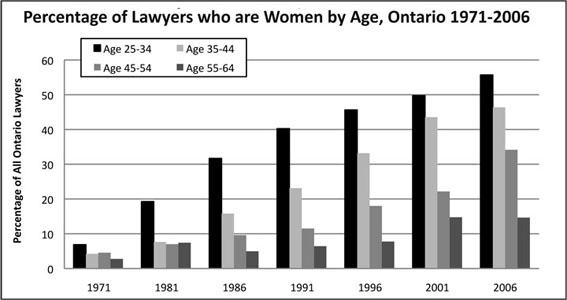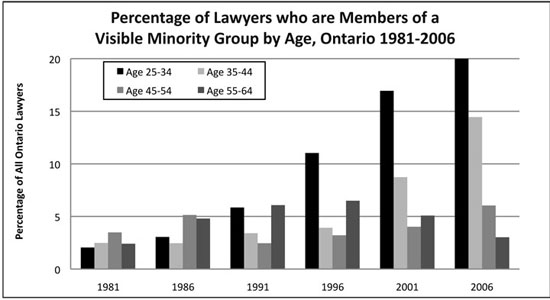Nearly 60 per cent of the youngest lawyers in Ontario are women, a significant demographic shift driven in large part by the increasing number of "racialized" women entering the profession, according to a report released by the Law Society of Upper Canada last week.
“While we are pleased to see the continued increase in the number of women lawyers, we are particularly happy to see the broadening diversity of those entering the profession,” says LSUC equity adviser Josée Bouchard. “We are witnessing a surge in the number of racialized lawyers mirroring the surge of women lawyers that took place 20 years ago.”
Below is the executive summary of Ornstein’s report outlining its main points.
RACIALIZATION AND GENDER OF LAWYERS IN ONTARIO
By Michael Ornstein
The legal profession in Ontario is changing dramatically. The number of lawyers who are women, aboriginal, and members of a visible minority continues to grow, transforming the face of a profession that until the early 1970s was primarily white and male. Drawing on Canadian censuses, this report provides a statistical portrait of a profession in the midst of fundamental transition. The research is based primarily on the 2006 “long form” census questionnaire, completed by one-fifth of all households. Information about 6,400 lawyers is used to describe the total of about 32,000 Ontario lawyers.
Leading the transformation is an extraordinary increase in the percentage and number of women lawyers. Accounting for just five per cent of Ontario lawyers in 1971, growth in the number of women lawyers has continued unabated for 35 years. In 2006, women accounted for nearly 60 per cent of the youngest lawyers and 38 per cent of all lawyers in Ontario. This trend will continue as older, predominantly male cohorts retire.
 In the last decade, gains in the representation of women are attributable largely to increased numbers of racialized women. Racialized women account for no less than 16 per cent of all lawyers under 30, compared to just five per cent of lawyers 30 and older; racialized men account for seven per cent of lawyers under 30, compared to six per cent of lawyers 30 and older.
In the last decade, gains in the representation of women are attributable largely to increased numbers of racialized women. Racialized women account for no less than 16 per cent of all lawyers under 30, compared to just five per cent of lawyers 30 and older; racialized men account for seven per cent of lawyers under 30, compared to six per cent of lawyers 30 and older. The percentage of Ontario lawyers who were aboriginal was unchanged between 1981 and 2001, but increased from 0.6 to 1.0 per cent between 2001 and 2006. In 2006, it is estimated that there were 315 aboriginal lawyers in Ontario. Aboriginal persons are 1.96 per cent of the Ontario population and 0.57 per cent of all university graduates with occupations. Relative to the number of aboriginal university graduates with an occupation, there are about twice the expected number of aboriginal lawyers.
In 2006, 3,685 or 11.5 per cent of all Ontario lawyers were members of a visible minority, up from 9.2 per cent in 2001. To compare, members of a visible minority accounted for 23 per cent of the total Ontario population in 2006, 22 per cent of Ontarians with an occupation, and 30 per cent of Ontario university graduates with an occupation.
The progress of visible minority lawyers can be seen in the dramatic increase in the percentage of lawyers between the ages of 25 and 34 who are members of a visible minority: two per cent in 1981, three per cent in 1986, six per cent in 1991, 11 per cent in 1996, 17 per cent in 2001, and 20 per cent in 2006. This trend will also continue as older, predominantly white lawyers retire.
There is wide variation between visible minority groups. There is one black lawyer for every 750 members of the black community, one for every 627 South Asians, and one for every 755 members of the Chinese community. In contrast, there is just one Filipino lawyer for every 2,730 members of that community, one for every 1,649 Latin Americans and one for every 994 Southeast Asians. These numbers are affected by the proportions of university graduates in the different groups.
 The percentage of lawyers who are immigrants from the U.S. and from the combination of the U.K., Ireland, Australia, and New Zealand is roughly the same as their representation in the Ontario population. Immigrants from countries whose dominant population is considered a visible minority in Canada, however, are less likely to be become lawyers than members of that visible minority community who are not immigrants.
The percentage of lawyers who are immigrants from the U.S. and from the combination of the U.K., Ireland, Australia, and New Zealand is roughly the same as their representation in the Ontario population. Immigrants from countries whose dominant population is considered a visible minority in Canada, however, are less likely to be become lawyers than members of that visible minority community who are not immigrants.In Ontario in 2006, members of a visible minority accounted for 30.7 per cent of all physicians, 31.7 per cent of engineers, 17.6 per cent of academics, and 11.8 per cent of high-level managers, compared to 11.5 per cent of lawyers. This suggests that potential immigrants who are already lawyers in countries with dissimilar legal structures believe they will be unable to translate their skills in Canada as easily as other professionals. Even immigrants who come to Canada when they are young children are disadvantaged in pursuing a legal career.
While women and racialized persons are transforming the face of the legal profession, they encounter barriers within the profession. Women and racialized persons are more likely to be law firm associates and employees and less likely to be partners in law firms. Women and racialized persons are also more likely to work in government.
Women and especially visible minority lawyers earn less than their white male counterparts. Relative to men, the earnings of women lawyers increased substantially between 1970 and 1995, but there has been little improvement since. At the start of their careers the earnings of women and men are very similar, but a gender gap opens up at the age of 30 and its size increases with age. In 2005, the median earnings of women aged 35 to 39 were 15 per cent below the median for men that age, and the mean was 20-per-cent lower; for lawyers 45 to 49 the median earnings for women were 16-per-cent lower and the mean was 28-per-cent lower.
There is strong evidence that racialized lawyers have lower earnings than white lawyers the same age and this difference is much larger than the gender difference. The difference in the median earnings of racialized and white lawyers, just $4,000 per year for lawyers between 25 and 29, grows to more than $40,000 by ages 40 to 44. The difference in mean earnings is even larger. The picture is not complete because there are too few middle aged and senior visible minority and aboriginal lawyers to accurately estimate their earnings.
Because the censuses do not describe individuals’ careers or the details of where they work, they can provide only a limited understanding of earnings differences, pointing to the need for further research.
The future will bring an increasingly diverse legal profession. Profound demographic changes will challenge the profession to achieve corresponding cultural change and equity within the profession.
The full Ornstein report is available here: http://www.lsuc.on.ca/media/convapril10_ornstein.pdf.







